Why the geyser strongly heats water and the case: how to prevent overheating
People have been using gas water heaters for over 100 years. They appeared in our country in 1956. The most popular were instantaneous water heaters, whose popular name is gas water heaters.
Agree that this device is much more reliable than a boiler. However, there are frequent cases when the gas column heats water strongly. The temperature of the heated water should not be too high, since this causes a lot of inconvenience and adversely affects the water heater.
We will examine in detail the possible causes of this problem and the most effective ways to solve it. Do not rush to call the wizard. Try to repair the gas column yourself, and we will help you with this.
The content of the article:
The device of a flowing water heater
The geyser is able to instantly change the temperature of the water, which is subjected to heating according to a once-through circuit. There is no tank in this equipment. The device has a plate heat exchanger, most often made of copper.
A water tube passes through it. Gas burners are located below. The heat exchanger plates are heated by burning gas and, in turn, heat the water tube.

At the top of the device is an exhaust manifold. In it, the products of combustion of blue fuel are accumulated and redirected to the chimney. On the body of gas boilers there are regulators with which the water pressure and gas supply are adjusted. Thanks to them, the temperature of water heating is set individually.
Recommended temperature values - not higher than 42-50 ° C.Higher temperatures lead to active salt deposition on heater parts. As a result, excessive heating of the gas column body occurs, and very hot water flows from the tap.
Reasons for overheating water column
There are several reasons why a geyser greatly overheats water:
- clogged heat exchanger;
- minor water pressure;
- untimely filter replacement;
- incorrectly set regulators;
- low throughput of the mixer.
Most often, a clogged heat exchanger is the reason for strong heating of water or the boiler body itself. Also, overheating can be a consequence of turning on the equipment with blocked water pipes and heating pipes.
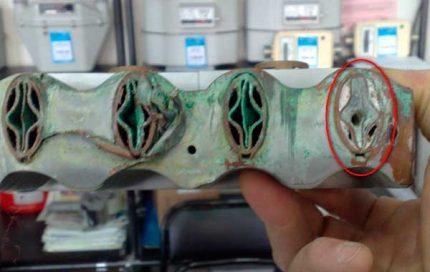
To identify the true cause, it is recommended first of all to check the operation of the pump and the water circulation in the heating system.
Low water pressure
If the water in the tap is extremely hot, then cold, the reason for such a “swing” is poor pressure in the line or a mismatch in the water pressure with the column power. The throughput of such brands as Bosch, Ariston, Baltgaz, Nevalyuks, Electrolux, etc. 11 l / min. With a slight pressure, overheating occurs.
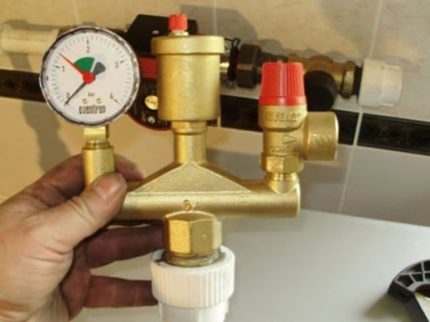
To solve the pressure problem, contact the city water utility.
Untimely filter change
The quality of the water in the water supply leaves much to be desired. To minimize its destructive effect on equipment, a mesh type filter is installed. It retains small debris, cleans water from impurities and softens it.
If the filter has not been changed for a long time, then water with magnesium and potassium salts falls into the column. As a result, scale deposits on the parts. This calcium precipitate often contributes to equipment breakdown.
Incorrectly set controls
Do you timely change the position of the regulator depending on seasonality? Often the cause of strong heating of water gas column is the change of seasons of the year. In spring, the water in the communications becomes warmer, and the gas supply regulator is set to the maximum value.
At the same time, the water supply regulator remains at a minimum level (as in winter). As a result, in the summer the water gets too hot.
Low mixer throughput
Another common problem is when the temperature of the water in the kitchen is comfortable, and boiling water is pouring from the shower.
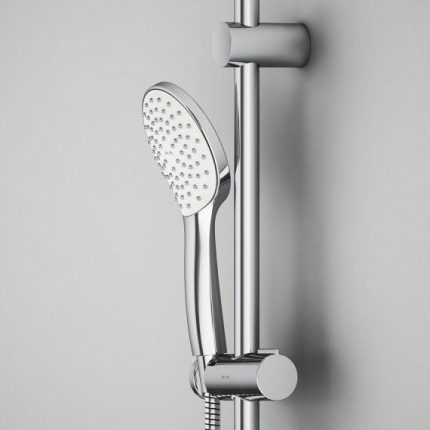
In this case, the problem is caused by the low capacity of the mixer in the shower. The only solution is to purchase a mixer with maximum throughput.
How to troubleshoot
If the body of the geyser is heated due to contamination in the communications, then they should be cleaned. To do this, check the inlet and outlet water hoses, the axle box and the cartridges for the mixer. Hoses are cleaned under running water.
If the controller is installed incorrectly, it is necessary to transfer the operation of the water heater to summer mode. The initial temperature of the outlet water is affected by the temperature indicator of the inlet fluid. For example, a device heats water to + 35 ° C.
In summer, the inlet water temperature is + 15 ° C. Therefore, at the outlet, the liquid warms up to + 50 ° C. In winter, when the inlet water temperature is lower, this indicator also decreases.
Descaling the heat exchanger
If you are heating the gas column housing, it is worth checking the condition of the heat exchanger. Since water is heated by gas, over time, parts of the equipment become covered with soot and scale.
The channels of the tubes of the heat exchanger become clogged with salts due to hard water, which disrupts the circulation of the liquid. To restore the gas boiler, it is necessary to clean the heat exchanger.
First of all, shut off the gas supply and disconnect the equipment from the power supply. After the device cools down, it is necessary to disassemble the boiler according to the instruction manual. After removing the filter, it is cleaned mechanically. If the condition of the part is extremely running, its replacement is recommended.
Hydrochloric acid purification
The first reagent for self-cleaning the heat exchanger is hydrochloric acid.
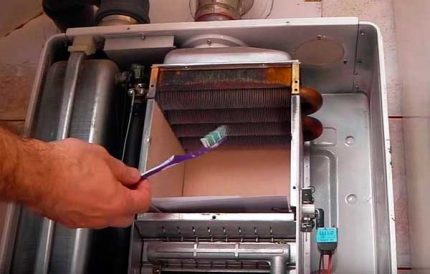
Procedure for cleaning with hydrochloric acid:
- turn off the water and drain all the hot liquid by opening the mixer;
- remove the casing;
- unscrew the screws holding it;
- disconnect the threads of the heat exchanger (water may pour, therefore it is recommended to substitute the container);
- prepare a solution of hydrochloric acid (not more than 3-5%);
- Using a ½ inch pipe or hose, connect the radiator inlet and outlet;
- install a funnel on the pipe and pour the solution into it.
All work must be carried out with gloves. As a result of the reaction of hydrochloric acid and scale, a foam may form. After cleaning, rinse the heat exchanger from acid residues.
Cleaning with a pump tank
For work, prepare a 7-10% acid solution. You will also need a tank and a centrifugal pump.
Sequencing:
- turn off the gas and water supply;
- drain the remaining water by opening the mixer;
- unscrew the bolts to disassemble the casing and gain access to the radiator;
- pour the acid solution into the tank;
- connect the treatment system to the heat exchanger;
- start the pump.
Run the fluid through the heat exchanger for an hour until all impurities are removed. If necessary, after cleaning, the poured reagents should be neutralized with a special solution or washed well with water.
The use of citric acid
Take a deep container in which the heat exchanger can fit freely. For 700 ml of water, 80 g of citric acid will be required.
Fill the container with approximately 30% water, immerse the radiator in it and fill in the acid solution. Heat the contents for 30 minutes.
Before assembling the device, rinse the parts under running water to remove any residual scale. Preventive cleaning is recommended once a year.
After cleaning the heat exchanger, all parts of the gas column are connected in the reverse order. Before operation, check the operability of the entire device. With timely cleaning, the gas column will last as long as possible, and the heat exchanger will not consume more gas.
Geyser Care and Maintenance
Regular care is important for reliable and long-lasting operation of the device. Each year of operation, the boiler should be inspected, preventive cleaning of parts, inspection of control and safety elements, as well as tightness of gas and water distribution.
In order for the gas boiler to work correctly, it is necessary to control the pressure coolant at the exit of the equipment. If the pressure is below 0.8 bar, the heating system must be supplemented.
Annual prevention includes:
- checking traction and operability of gas equipment;
- inspection of the condition of the heat exchanger;
- traction and ignition test;
- inspection of the structure and determination of the need for cleaning the housing.
Most often, once a year, it is enough to clean the heat exchanger, housing and burner.
When changing seasons, it is necessary to prepare equipment for further operation. Most often, the check is carried out before the onset of cold weather, when the load on the device increases.
Conclusions and useful video on the topic
Gas boiler troubleshooting:
DIY heat exchanger cleaning:
The geyser is equipment that provides uninterrupted preparation of hot water and serves individual heating. That the device worked correctly, it is necessary to carry out its routine inspection regularly. Without this, the equipment will quickly break down and require major repairs or the purchase of a new boiler.
Share in the comments your history of the operation of the gas boiler, as well as what malfunctions you had to deal with and how you got out of the situation. If you know other ways to clean the heat exchanger yourself, tell us about it by filling out the form below.

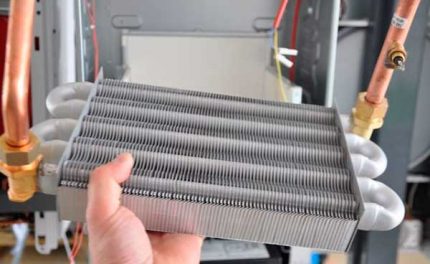
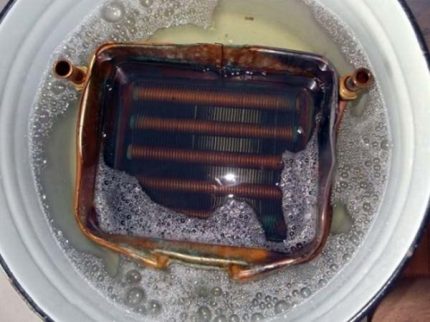
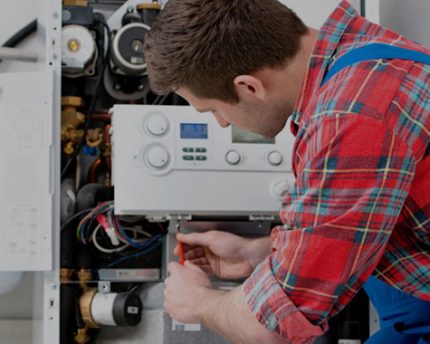
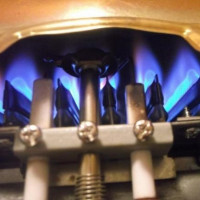 The gas column ignites and goes out: why the column goes out and how to fix it
The gas column ignites and goes out: why the column goes out and how to fix it 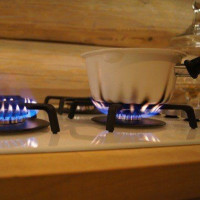 Why smokes a gas stove with a propane tank: basic breakdowns and troubleshooting tips
Why smokes a gas stove with a propane tank: basic breakdowns and troubleshooting tips 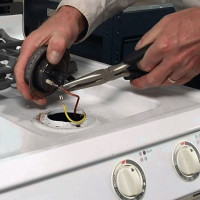 Why the gas stove does not hold the flame, the oven goes out and the burner goes out: an overview of the reasons and repair tips
Why the gas stove does not hold the flame, the oven goes out and the burner goes out: an overview of the reasons and repair tips 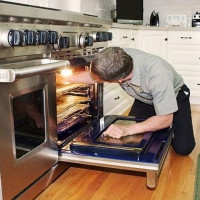 A gas oven does not bake well: why does the oven not bake from above and below and how can this be eliminated
A gas oven does not bake well: why does the oven not bake from above and below and how can this be eliminated 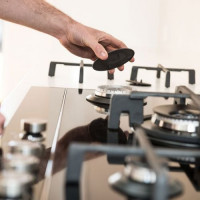 Why the burner does not work on the gas stove: common causes and methods for eliminating them
Why the burner does not work on the gas stove: common causes and methods for eliminating them  Why gas burns red flame on the stove: factors affecting the color of the flame
Why gas burns red flame on the stove: factors affecting the color of the flame  How much does it cost to connect gas to a private house: the price of organizing gas supply
How much does it cost to connect gas to a private house: the price of organizing gas supply  The best washing machines with dryer: model rating and customer tips
The best washing machines with dryer: model rating and customer tips  What is the color temperature of light and the nuances of choosing the temperature of the lamps to suit your needs
What is the color temperature of light and the nuances of choosing the temperature of the lamps to suit your needs  Replacement of a geyser in an apartment: replacement paperwork + basic norms and requirements
Replacement of a geyser in an apartment: replacement paperwork + basic norms and requirements